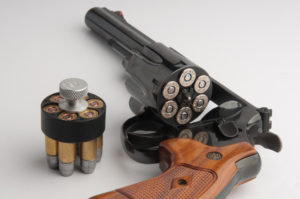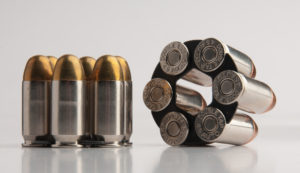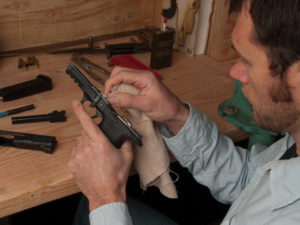
Revolvers and semi-automatics are very different beasts, though both are capable personal protection arms. The key to solving the semi-automatic vs. revolver debacle is knowing the differences and choosing what best fits your environment and needs.

via the use of a Speedloader.
Semi-automatic handguns are typically the better choice for suburban and in-home use and, when cared for and kept clean, are the flavor of the day in what I’ll term combat zones—whether an Afghanistan outpost, a disaster area overrun by consequence-free crime, or an apocalyptic end-of-days scenario.
Revolvers, on the other hand, are the better option when sand, dust, and involuntary neglect add up to an environment that may challenge a semi-auto’s reliability. They are just more reliable in very dirty conditions. Also, revolvers tend to be chambered for more powerful cartridges—sometimes much more powerful—than semi-autos. While this is an advantage in the backcountry or around livestock and heavy predators, it’s a disadvantage in an urban neighborhood composed of thin walls and sleeping children.
Can the two vastly different handgun types cross over in usefulness? Absolutely. However, each has its strengths and weaknesses.
Revolvers
Since revolvers don’t depend on harnessing the energy of a cartridge to function, like semi-autos do, there’s just one less thing to go wrong. Squib loads, dud primers, a tight cartridge too stubborn to chamber easily—none of these affect revolvers. Additionally, since human muscle works a revolver’s action, bits of sand, lint, dust, or fouling that would choke a semi-auto can be overcome by, well, a little more muscle. Just ear that hammer back and let fly.
As mentioned earlier, the magnum cartridges frequently chambered in revolvers can offer quite an advantage for rural use, too. They provide more downrange reach, more downrange energy, and typically a great deal more penetration—important when scraping an enterprising black bear out of the bacon griddle next to your tent, or trying to kill a wigged-out saddle horse that’s running like a banshee while you bounce along the cactus-covered ground with your boot stuck in the stirrup.
Revolvers are slower to reload. With practice and a good speedloader (a device that holds the bases of a cylinder-worth of cartridges, and drops them into the open cylinder of a double-action revolver at the twist of a knob) or moon clip (a spring steel device that holds a cylinder-full of cartridges, and goes into and out of the gun with them), a good revolver man can get back into action pretty quickly. But, speedloaders and moon clips are awkward to carry, and it takes good training to achieve speed and surety. Single-action revolvers are even slower. Much slower.
On the plus side, your revolver will never turn into a one-shooter because you misplace your magazines. And if you’ve got a little survivalist in your nature, you’ll appreciate the fact that empty cartridge brass is easy to collect—just dump it into your pocket after ejecting it. With care, you’ll never loose a piece, and you never have to hunt for little sparkly brass bits flung indiscriminately away by your greedy semi-auto.

Revolvers have the appealing virtue of simplicity. Neophyte shooters intuitively grasp how they function, and the lack of slides, slide stops, magazine releases, decockers, and safeties of various flavors is attractive. Many women opt to carry a compact revolver for that winsome simplicity, frequently compounded by the fact that petite women sometimes struggle to pull back a semi-auto pistol’s slide in order to chamber a cartridge.
As I see it, the revolver has only a few drawbacks as a prime personal protection sidearm. They have limited capacity, they are slow to reload, and the cartridges for which they are chambered are often overpowered for city and in-home use.
The first two drawbacks are what they are, and shooters opting for a revolver should plan on spending time practicing reloading in order to even the odds a bit. The over-power issue, on the other hand, can be turned to the owner’s benefit by choosing ammunition with hollow-point projectiles designed for dramatic expansion, in a light-for-caliber weight. The effect is two-fold: With less mass, projectiles will penetrate less, and the large, on-impact expansion will slow bullets down, dumping more energy into the bad guy and reducing the chance of a pass-through that could potentially endanger family members or neighbors.
It boils down to this: With the correct ammunition and some quality practice-time manipulating the gun, a revolver will do anything you’ll ever need it to.
Semi-automatics

As far and away the most popular type of sidearm for personal protection, the semi-auto’s primary attractions are high capacity and excellent rapid-fire capability. With correct maintenance and quality ammunition, good semi-autos are very reliable, too.
I grew up carrying a revolver while working cattle in Southwestern desert country. None of the guys I knew owned a semi-auto because prevailing opinion was that they couldn’t cut the mustard in the country and conditions in which we worked. I’ve since learned differently—a good semi-auto can take an awful lot of abuse and still function reliably.
When I first started carrying a semi-auto (a Colt Gold Cup 1911 in .45 ACP) it wasn’t for high capacity, it was for the rapid-fire characteristic. The Colt didn’t really offer much in the way of additional round count—my surplus G.I. magazines were seven-rounders. Heck, my single-action .44-40s held six. But I couldn’t shoot a single-action as quickly as a semi-auto, and though I could hose rounds downrange pretty quickly out of a double-action, I couldn’t shoot it fast nearly as accurately as my 1911.
Speed is one of the most important advantages that a semi-auto offers the average person. Sure, there are revolver shooters who can shoot faster and more accurately than 99 percent of the semi-auto shooters out there, but the reality is that, for most folks, semi-autos are a little easier to shoot fast than revolvers.
Throw in high capacity, and you’ve got a very supportable argument that the semi-auto makes a better personal protection gun than does a revolver. Truth is, most of today’s popular designs hold more cartridges than a wheelgun—usually a lot more. Even a modern magazine in a .45-caliber 1911 holds eight rounds, plus one in the chamber. That’s a total of nine, for a 50-percent increase on the capacity of most revolvers. Throw in high-capacity guns, such as Glock’s G17, Smith & Wesson’s M&P9, and Springfield’s XD(m), all of which contain 17+1 to 19+1 rounds in the magazine, and you’ve got three times the capacity of a revolver. Three times! Add a couple of easy-to-carry magazines in innocent-looking belt sheaths, and you can comfortably carry over 50 rounds on your person.
You can argue that, in most of today’s typical defensive encounters, you shouldn’t need even a tenth that number. You’d be right. However, what about that non-typical encounter? Or—admit it, we all think about it—an end-of-days scenario? There are a lot of situations in which it would be mighty comforting to have 50-plus rounds available.
Semi-autos do have some drawbacks. They are clean freaks. They are also picky about subpar ammo. Whereas a revolver will accept anything that fits properly into a cylinder chamber and will dutifully fire it downrange, a semi-auto must have cartridges with the correct bullet nose geometry for reliable feeding, enough propellant to fully function the slide but not so much that it batters the internal mechanics, correct case length for proper headspacing… all this within spec so that it flows into the chamber and out again without hanging up in a gun powered purely by energy harnessed from the explosion of the cartridge itself. Looked at from an informed, objective position, that’s a lot to ask. It’s a marvel than so many semi-autos are the reliability champs that they are.

The very magazines that provide high-capacity firepower can—if lost or damaged—cripple a semi-auto and, in essence, turn it into a single-shot. Or worse, incapacitate it completely if it’s one of the models with a magazine disconnect safety that prevents it from firing unless a magazine is inserted. These days, we take magazines pretty lightly, as most of us have a spare or several. But in the early days of semi-autos, folks considered the potential more gravely. Many early models—especially those of European design—didn’t allow magazines to fall freely when released; this influence extended up through the first-generation Glocks.
Limited energy and penetration are another characteristic of shots fired from most semi-auto handguns. In many scenarios, limited penetration is an advantage. A 9mm hollow-point projectile is much less likely to penetrate through walls than a classic soft-point .357 Magnum projectile. But it does limit a semi-auto’s suitability for certain tasks. I know of two Alaskan bear guides who carry semi-auto .45 ACP pistols for backup. What tomfoolery. Even the more powerful revolver calibers (until you get to the obscenely powerful .500 S&W Magnum) are unsuitable for stopping a bear with uncivilized intentions, let alone a semi-auto with very limited penetration and (in bear terms) not nearly enough energy on impact.
However, we’re discussing personal protection firearms here, and none of the above semi-auto drawbacks really apply. Shoot quality ammunition, and purchase plenty of magazines and keep track of them diligently. As long as you attend to those two details, a good semi-auto makes more sense than a revolver most of the time.

Next Step: Get your FREE Printable Target Pack
Enhance your shooting precision with our 62 MOA Targets, perfect for rifles and handguns. Crafted in collaboration with Storm Tactical for accuracy and versatility.
Subscribe to the Gun Digest email newsletter and get your downloadable target pack sent straight to your inbox. Stay updated with the latest firearms info in the industry.

![Best Concealed Carry Guns In 2025 [Field Tested] Wilson Combat EDC X9S 1](https://gundigest.com/wp-content/uploads/Wilson-Combat-EDC-X9S-1-324x160.jpg)


![Best 9mm Carbine: Affordable PCCs [Tested] Ruger Carbine Shooting](https://gundigest.com/wp-content/uploads/Ruger-Carbine-Shooting-100x70.jpg)
![Best AR-15: Top Options Available Today [Field Tested] Harrington and Richardson PSA XM177E2 feature](https://gundigest.com/wp-content/uploads/Harrington-and-Richardson-PSA-XM177E2-feature-100x70.jpg)

If you can shoot and need power, get the revolver. If you can’t shoot worth a damn, get the high-capacity semi-auto and hose down the neighborhood.
“Squib loads, dud primers, a tight cartridge too stubborn to chamber easily—none of these affect revolvers.”
Sorry and in spite of your credentials as an expert, YOU ARE WRONG!!! In the 45+ years of working on firearms, I have had several occasions where a revolver had a squib load that resulted in the bullet lodging in the forcing cone or even the barrel rendering the revolver inoperative and even dangerous! The worst case I had was a former Marine who had all the answers, but hadn’t learned all the questions. This dolt was using his “more reliable” 6″ S&W 19 that had set on his shelf for x years. He only became “aware” of a problem when he “fired” all 6 cartridges that had been in the gun since whenever. At 7 yards, he had no holes in the paper. He then tried to open the cylinder, no go. He was lucky she was using .38SPL ammo and extra lucky that ALL six rounds had suffered the same problem, contaminated with oil. The first bullet never cleared the barrel and the other five just stacked up behind the first. The barrel/cylinder gap allowed the gas to escape just enough to keep from having a catastrophic issue! If ANY one of those rounds have been at full power… Well, no telling. And it would have been even worse if he had been using .357 Mag ammo!
Yes, it may be an isolated event, but I have had about a dozen events like it, but not to the extreme of this one! However, my experience has been that when (not if) a revolver has a MALF, it usually takes an armorer or gunsmith to repair. Just the other day I had a customer with a new Ruger SP-100 that “locked up” while he was shooting it. Wouldn’t index to next round, couldn’t open cylinder. Finally, after I tapped the cylinder with a soft faced mallet, I got the cylinder open. The “problem” was a factory new round with a nick on the rim that kept the round from fully seating in the chamber and the round was lodged against the recoil shield right where it reduces the gap behind the cartridge. Had this been a semi-auto, it the cycling would have overcome that ding, but there is very little leverage in a double action revolver. The taps of my mallet was enough to peen the nick in the rim so we could open the cylinder.
And Glock has a little trick they use to “sell” the reliability of their pistols. When Glock is in a demonstration/competition for a contract, they will offer to go “last”. After the initial shooting, they will then say “watch this” and remove a part from their pistol. It may be a “minor” part, but a part is a part and their pistol will run without it. There are more than a couple of parts that can be removed that will not totally disable the pistol. I won’t mention which ones they are since I don’t want some FKIA trying it out. The pistol may not fully cycle, but it will fire!
Thanks, but I will keep my semi-auto, even if I have to rack the slide each time!
I can’t explain why so many LE units are replacing their Glocks either. Going to other semi makes.
I prefer a revolver for the variety of ammo and bullet types that can be used. My 357 mag will shoot 38 special target loads, squib loads and Buffalo Bore equally well. Some of the loads I can see the bullet hits the target and others will leave you blind at night. The only auto I use is a .22 LR pistol, For serious work I prefer my six shooter. I am fairly proficient with a speed loader. My .44 mag is right at home with .44 specials also. It is a matter of choosing the correct ammo for the job at hand. That is something you can’t do with an automatic.
Bah, I think the “overpenetration” thing is overstated a bit. I know how much dry wall will stop a .45ACP +P and it’s not really that much. Non +P .357 are probably as powerful as you’d need in a self defense revolver and the recoil isn’t that bad – try a Chiappa Rino! Further, in my experience in a hi-adrenaline situation, I never noticed the recoil or the report for that matter. I don’t think anybody in a real self defense situation is going to go “golly, that thing kicks like a mule!” And I’d add, if the weapon somebody is considering for self defense is kicking out energy in the 200lb range or lower, then that’s probably too light.
I bought my wife semi-autos for years, and she hated all of them. She absolutely favors the small revolvers (which I ensure are .38spc/.357s – one for plinking and confidence building…) because of what was written: reliable, no slide, no safeties to remember, not hard to check the chamber to remember if there’s one in there etc. I’d rather her be able to use the thing when she needs to and not have to worry if she’ll remember to rack the slide.
Obviously everything is situation dependent. My preferred carry guns are either a 10mm on a 1911 platform or a Kahr PM45 with +Ps, the only time I carry hi capacity is when I pack a Glock20 in bear country (small bears where I live in the Arizona mountains).